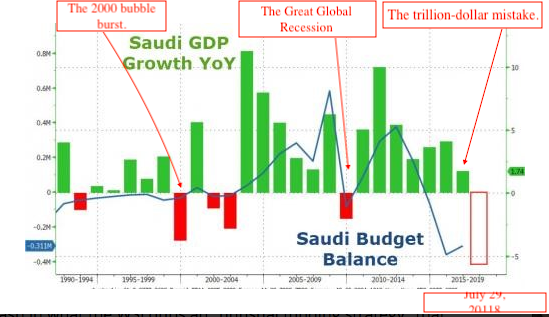- Apple, Inc: best "June" quarter ever; AAPL should hit $200/share by end of August; when it hits $203/share, Apple's market cap is $1 trillion dollars; Amazon market cap is about $870 billion;
- huge US crude oil inventory build, API: WTI slumps -- a build of 5.95 million bbls -- that's a pretty big build during height of US driving season; EIA reports tomorrow
- critics want US military to buy less Russian oil; as much as 40% of oil used at US installations in Europe is -- OMG -- Russian oil -- truly amazing, huh? I thought US / Trump was being tough on Putin -- all talk?
- peak oil? what peak oil? Guyana elephant bigger than initial estimates;
- nuclear reactor damaged during ramp up to back up renewable energy;
Nuclear energy demand in Germany fell by nearly 11% in 2017. One reactor was shut down at the end of December, but that decrease was only slight. A bigger factor was the extended downtime at Brokdorf, a reactor that made history last year by being the first nuclear plant to shut down specifically because of damage caused by ramping. Other reactors, such as France’s Civaux, have also experienced difficulties possibly related to load-following, but ramping was never clearly reported as the cause for any other reactor -- a reader sent me that -- neither of us could make that up --
*******************
Back to the Bakken
Active rigs:
| $68.42↓↓ | 7/31/2018 | 07/31/2017 | 07/31/2016 | 07/31/2015 | 07/31/2014 |
|---|---|---|---|---|---|
| Active Rigs | 63 | 61 | 35 | 74 | 193 |
Three new permits:
- Operator: WPX
- Fields: Squaw Creek (McKenzie); Heart Butte (Dunn)
- Comments:
- EOG (3): three Hawkeye permits in McKenzie County
- Statoil: a Martin permit in Williams County
- Enerplus: a Wallaby permit in McKenzie County
- Abraxas: a Lilli-George permit in McKenzie County
- 32755, 1,400, XTO, Bear Creek 31X-3BXC, Bear Creek, t5/18; cum 31K 6/18;
- 32756, 1,223, Bear Creek 31X-3F2, Bear Creek, t5/1; cum 21K 6/18;
- 33257, 1,649, Whiting, Wold Federal 44-7-6TFXH, Banks, t7/18; cum -- (#19468)
Hess: a CA-Anderson Smith permit in Williams County







